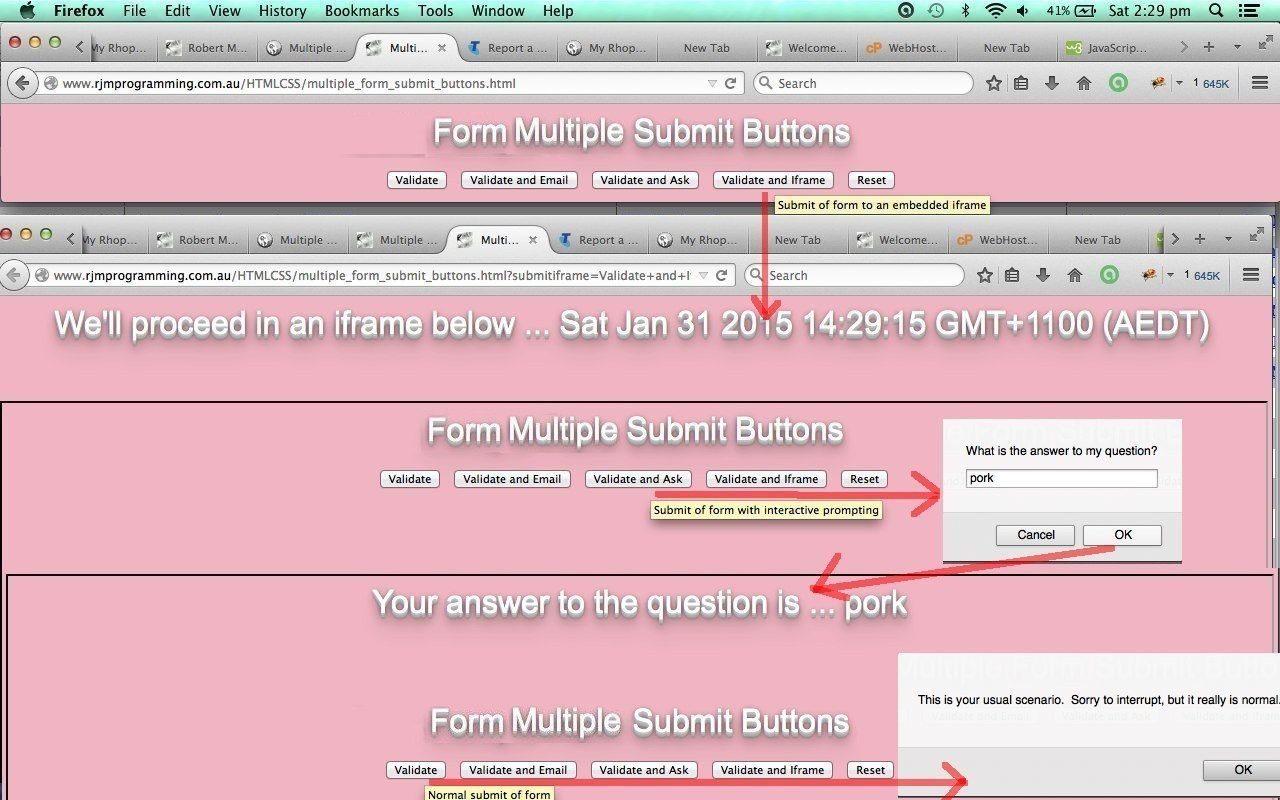Today we want to discuss a very old HTML concept called the form tag which allows for the processing of interactive input from the user in the form of textboxes and checkboxes and radio buttons and buttons to transfer information from one webpage to another, somewhere.
For clarity, today, we only use buttons, and you may ask, “What good are buttons on their own for imparting information?” … and will ignore the obvious answer that a button press anywhere, depending on the event logic, can mean so much … after all, we all envisaged the disaster of a nuclear holocaust envisaging the press of one button … no, we want to talk about the idea that you can have more than one input tag with type=’submit’ … and this was not always the case, because in the early days of HTML there was the one submit button allowed on one HTML form … now you can even have more than one form … but this is for another day.
Anyway, you might still ask, anyway, “Ignoring the huge event logic possibilities of a button press (because you are not trying to trick me here), what good are buttons on their own for imparting information?” … well, it means on the callback … and today we just callback the same HTML code (via the form‘s action= designation of itself, today) … as we often like to do at this blog, by the way … we can compartmentalize via the GET (in our form’s method case … for starters, with POST we’d need Ajax or a server language, and remember we are trying to keep things more basic here) parameters in the callback URL (stored in “Javascript DOM land” as document.URL) according to the value of that submit button whose name becomes that GET parameter’s name … so that for an HTML form‘s submit button like …
<input type='submit' title='Submit of form to an embedded iframe' onclick='cif();' name='submitiframe' id='submitiframe' value='Validate and Iframe'></input>
… its contributing part of the callback URL, in our code, is …
... ?submitiframe=Validate+and+Iframe ...
… and so we can, in Javascript, at the onload event‘s code … have an else if statement like …
} else if (document.URL.indexOf('iframe=') != -1) {
// do something here
}
… to have a good compartmentalizing of “action” segments of code that is quite readable and understandable.
If the case is not clear … please tee up a live run with the HTML programming source code multiple_form_submit_buttons.html … or else please try some HTML code yourself … the hardest concept here today is the embedding of an iframe in a hierarchical way (note the Javascript DOM manipulation of the form‘s target= designation, as you examine the downloadable code above), and so for clarity we preface any iframe by a current client (ie. Javascript) timestamp, so you know who inherits who etcetera etcetera etcetera.
Now even after all this, you may want to say, “So what … an HTML a tag link can do all this. … to which we say … that’s true … good to know there is more than one way to “skin a cat” … meowwwwwwww! … “no animals were harmed in the making of this tutorial”.
In fact you could go on and on and on with possibilities for the equivalent means by which to achieve the ends we have here with our HTML, such as using an input type=”button” or in HTML5, a button tag, and all these and more and more and more and more are worth exploring, and trying, yourself, or by researching the subject. One day, in a real bind, with cross-browser issues, you may need that extra method, to make things work for all the platforms?!
Did you know?
With an HTML input type=”submit” (submit button), there is nothing stopping you storing more than just the “front look” of the button in its value= parameter. If you want to do this, but there is no way you want to show that “data” as the “front look” of the button, perhaps it really should be an input type=”hidden” piece of data, or you should hide it … via style=”display:none;” … Javascript DOM store data to it via document.getElementById([itsID]).value=[myData]; … and, conditionally perhaps, click it via Javascript, via document.getElementById([itsID]).click(); method.
If this was interesting you may be interested in this too.




18 Responses to HTML Form Multiple Submit Buttons Primer Tutorial